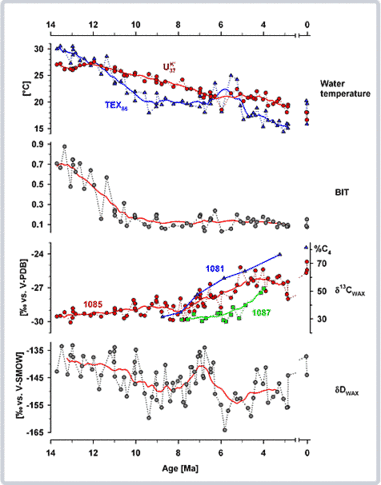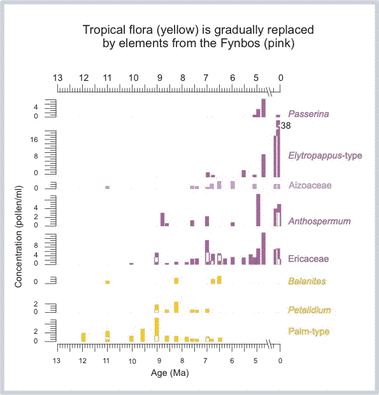Major results
- During the Miocene, ocean temperatures in the southern Benguela system (ODP 1085) detected by two organic proxies (UK37 and TEX86) decreased by about 8 and 16°C, respectively, suggesting enhanced inflow of cold Antarctic waters and intensification of wind-driven upwelling. The stronger decline in TEX86 temperatures resulted from displacement of producing organisms to sub-surface waters with increasing productivity. The Benguela upwelling system was established at 10 Ma (Rommerskirchen et al., in revision).
- Afromontane forests disappeared from SW Africa in the Late Miocene and coastal vegetation changed from tropical grassland and thicket to semi-arid succulent vegetation indicating increased summer drought in step with the development of the Benguela upwelling system. The marine-driven climate change in SW Africa triggered substantial radiation in the terrestrial flora, especially in the Aizoaceae (Dupont et al, 2011).
- Parallel to upwelling intensification, intensity of southerly and south-easterly winds increased and moisture flux onto SW Africa declined. Riverine soil organic matter contributions diminished whereas eolian transported pollen and spores increased. These changes are consistent with a northward shift and intensification of the South Atlantic high pressure system.
- C4 plant expansion, based on δ13C analyses of leaf waxes, started at 8 Ma in SW Africa (ODP 1085) paralleled by increased input from grass and desert plant pollen. Hydrogen isotope compositions of leaf wax lipids indicate cooling until 10 Ma followed by a pronounced aridification from 8 to 6 Ma. At around 6 Ma, the δD compositions depict a rapid shift to lighter values which likely reflects a change in moisture source area from predominantly Atlantic to Indian Ocean.
- Preliminary data along a N-S transect (ODP 1081: 20°S, ODP 1085: 29°S, ODP 1087: 32°S) reveals that C4 plant expansion started at 8 Ma in the northern sites (ODP 1081 and 1085) and showed the most pronounced increase at the northernmost location (ODP 1081). At the southernmost site C4 plant expansion occurred after 6 Ma. This is consistent with a higher sensitivity of C4 plant expansion under warmer climates. All records show that C4 plant expansion extended into the Pliocene.

Figure 1: Paleo-environmental evolution off SW Africa. Left: Ocean temperature development in the Benguela current system based on alkenones (red) and TEX86 (blue) at ODP 1085. Middle left: Decline of riverine organic matter contributions (BIT index) at ODP 1085. Middle right: Stable carbon isotope compositions of terrestrial plant waxes in ODP cores 1081 (blue), 1085 (red), and 1087 (green) showing the expansion of C4 plants. Right: Stable hydrogen isotope compositions of terrestrial plant waxes at ODP 1085 depicting global cooling until 10 Ma, aridification from 8 to 6 Ma and a sudden shift in moisture source regime around 6 Ma.

Figure 2. Concentration values in grains per mL of selected pollen taxa for the Middle to Late Miocene of ODP 1085. Pollen types from plants of tropical affinity disappeared, and those from the Cape flora gradually increased between 10 and 6 Ma.The Late Pleistocene values (rightmost) are denoted for comparison.
References
Dupont, L.M, Linder, H.P., Rommerskirchen, F., Schefuß, E. (2011): Climate-driven rampant speciation of the Cape flora. Journal of Biogeography, online. doi:10.1111/j.1365-2699.2011.02476.x
Rommerskirchen, F., Condon, T., Mollenhauer, G., Dupont, L.M., Schefuß, E. (2011), Miocene to Pliocene development of surface and subsurface temperatures in the Benguela Current system, Paleoceanography, 26, PA3216, doi:10.1029/2010PA002074.
Rommerskirchen, F., Dupont, L.M., Mollenhauer, G., Schefuß, E. (in preparation): Climatic changes favoring C4 plant expansion in SW Africa.


